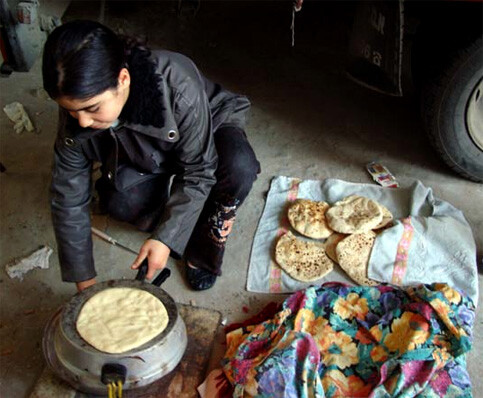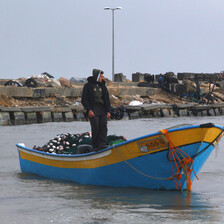Gaza Strip 10 January 2009

Bread is baked with a small electric stove. (Eva Bartlett)
It’s 2:50am and I can’t sleep.
Some mornings I wake up from a new explosion and realize I’ve somehow managed to fall into a sleep despite the blasts. Other mornings, I wake up disoriented, first wondering where I am, as I’m sleeping in some hospital waiting room or ambulance office, or the house of a driver since the Red Crescent office in eastern Jabaliya was first shelled and then made off-limits by the invading Israeli forces in the eastern Jabaliya region… and then in the north, the northwest, the east, the south …
Yesterday morning I awoke to an eerie near-quiet: for the time there were no bomb blasts, just the Israeli drones continuing to lord over the sky. Then the blasts came. At 8:38am I noted “resumption of loud, reverberating explosions. In the Saraya area again (the former British prison has been hit a number of times already)? 8:59 am: four very loud explosions with deep reverberations.”
At 12:15pm I’d noted and photographed the white stream of chemical clouds billowing over large expanses of eastern Gaza. At 1:05 pm: “Since last night until now, 23 persons have been killed, all civilians,” reporter Yousef al-Helo told me, adding, “This afternoon, two people — including women and children — were killed in a shelling on Beit Lahia.”
Yousef read me Israeli Foreign Minister Tzipi Livni’s response to the United Nations Security Council call for an immediate ceasefire: “Israel has acted and will continue to act according to its calculation in the interest of the security of its citizens and its right to self-defense.”
Yousef and I had discussed the violations of Israel’s unilaterally-imposed three-hour-ceasefire (which a Lebanese journalist summed up: “How would you like it if I was shooting at you and then told you I’d give you a minute to dance around before I kill you?”). John Ging, director of the UN agency for Palestine refugees (UNRWA) in the Gaza Strip, sums it up more diplomatically: “For three hours, the people of Gaza have some safety. That’s all it is.” During the first day of the supposed ceasefire between 1 and 4pm, Israeli forces killed three sisters (ages two, three and 10), one woman (31), two elderly men (60 and 87), and targeted paramedics, shooting one in the leg, as the explosions continued all over the Gaza Strip. At 6pm, two hours after the “ceasefire,” the official killing did indeed continue: a family of five dead in northern Gaza, returning from the bread lines with a prize bag of bread, bombed in their car, including three children aged 10 to 15, a 20-year-old cousin and 45-year-old father. And later, after 9pm, another medic was shot in the leg while trying to perform his duties.
With the medics last night, we’d arrived at the Sheikh Radwan neighborhood, to the smoking skeleton of a multi-story, multi-family house, evaporated. Fire trucks were there ahead of us, though we all collectively ran at one point, expecting the second strike that often follows the original destruction.
Later in the night, we kept passing the ruins of buildings bombed in the last days. I’ve lost track of what was bombed when. We come to a newly-bombed building, a newly-homeless family, the adjacent building facing a similar fate soon enough as it appears the structure has been so badly damaged it will eventually collapse.
3:20 am: I’ve left the bed and given up on feigning sleep. Am watching the darkness explode with the political hatred that not only kills but silences truth. Hatred in every blast pounding Gaza.
“They will not finish until the martyrs reach 1,000,” the nurse predicts, taking a break on his night shift. “They want to make Gaza into Guantanamo,” he goes on. “All of this will not break the Palestinian people.”
In the hospital room where I tried to sleep between an ambulance shift and morning obligations, the tank shelling and firing is in the room, landing on my pillow.
It’s the shells, which crack and blast. The staccato gunfire. The drones’ whine, in menacing pitches. The fighter plane’s sudden, thundering presence.
The drone ramps up the decibels, a train wreck of disharmony.
And the inevitable whoosh before the explosion, an F-16 launch which erupts a crater where someone’s house, or a market, or a mosque once stood. The blast an hour ago was a market, another nurse tells me. “It was a beautiful market, sold everything, everything we need,” she says.
Hours later, after the sun finally rises, women are walking onto the hospital premises, large towel-covered platters on their heads. A small electric stove is plugged in, and they take turns baking bread for their families: no gas, no electricity at home. They are lucky to have the flour to bake with, and I guess that a trickle of that little aid comes in has reached them. But it’s never enough.
The shelling continuing, I get to see Osama, who I’ve not seen for weeks, although he lives near the hospital where I spend much time. His family, like most, have taken all the windows out of their house (those not already blown out), and the house is frigid with cold. We talk, ask the same questions that everyone is asking every day, about when it will end, why it must be so, what value a Palestinian life has …
A new series of explosions, we go out to see, the latest strike just a couple of streets away, but that’s nothing. Osama’s family live in front of a house slated for attack at any time. “What can we do?” they ask, everyone asks.
Eva Bartlett is a Canadian human rights advocate and freelancer who spent eight months in 2007 living in West Bank communities and four months in Cairo and at the Rafah crossing. She is currently based in the Gaza Strip after having arrived with the 3rd Free Gaza Movement boat in November. She has been working with the International Solidarity Movement in Gaza, accompanying ambulances while witnessing and documenting the ongoing Israeli air strikes and ground invasion of the Gaza Strip.
Related Links





